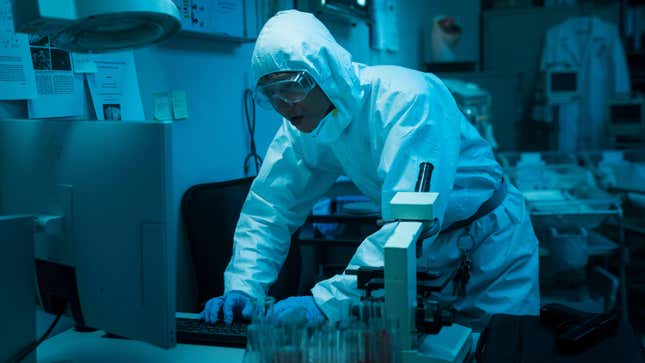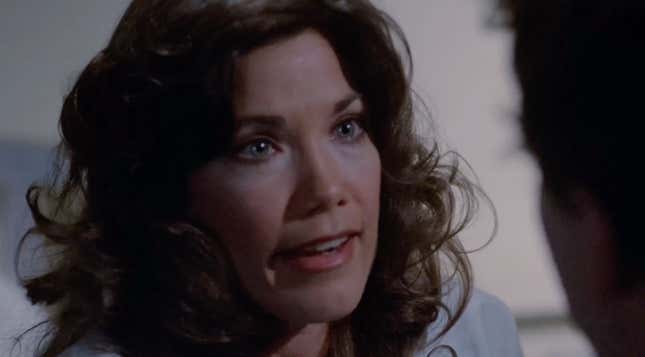
There are lots of horror movies themed around psychiatric hospitals—be they fully functional facilities, like A Nightmare on Elm Street Part 3: Dream Warriors, or abandoned, like Session 9. Regular medical hospitals don’t pop up nearly as often—but as these 10 films show, leaning into what’s already an unsettling atmosphere can be hugely effective.
After Laurie Strode survives “the night he came home,” she’s taken to Haddonfield Memorial Hospital for some much-needed medical care in this 1981 sequel to the slasher classic. Naturally, recovery takes a back seat when Michael Myers follows her there and starts adding to his body count. The recent Halloween sequel trilogy circled back to Haddonfield Memorial for its own part-two installment, 2021’s Halloween Kills, which also saw Laurie recovering from yet another bloody encounter with her nemesis.
What’s the worst thing that could happen to a person who needs to be constantly in motion to avoid the relentless entity that’s chasing her? How about being injured in a car crash and waking up in the hospital after an undetermined amount of time has passed? It Follows, which was released in 2014 but feels timelessly nightmarish, is full of scenes that are absolutely stuffed with dread, but the ticking-clock terror makes this one hit extra hard.
The original Exorcist is rightfully hailed as one of the scariest movies ever, but the hospital hallway death scene in 1990’s underrated threequel easily tops anything in the original. It’s the jump scare by which all others should be measured; even if you know it’s coming, it’s scary as hell every time.
After a horrific zombie-like virus—which turns the afflicted into weeping, viciously violent, distressingly horny manics—spreads across Taiwan, survivors seek refuge in a crowded hospital. Unfortunately, healing is not in the cards for anyone, and in fact the hospital is where 2021’s The Sadness’ already sky-high levels of gore and agony become exponentially more alarming.
Michael Crichton is best-known these days for spawning Jurassic Park, but his sci-fi influence also includes writing and directing 1973’s Westworld, and directing 1978 thriller Coma, which was adapted from Robin Cook’s book but plays into his own interests swirling around technology and medicine. It follows a doctor who becomes suspicious when a high number of patients at the hospital where she works start slipping into comas—and then realizes how fast “first, do no harm” can go out the window when a black-market organ ring is part of the picture. If you crave even more Crichton medical horror, double-feature Coma with The Terminal Man, which is based on his 1972 novel and explores some spooky ideas about using high-tech methods to tinker with the human brain.

Alternate titles for this 1982 slasher include Hospital Massacre and Be My Valentine, Or Else, which taken together paint a vivid picture of what to expect. In classic genre form, it follows a maniac seeking revenge for a humiliation he endured decades prior; less predictably, he poses as a surgeon and uses his faux-insider status to torment his victim, altering her perfectly healthy medical records to bring her into his clutches and making use of hospital-handy weaponry (orthopedic saw! Vat of acid!) when anyone gets in his way.
The American Grudge series had diminishing returns despite the involvement of Japanese creator Takashi Shimizu and producer Sam Raimi, but it’s not without its standout moments, including a scene near the beginning of The Grudge 2 in which Sarah Michelle Gellar’s hospitalized character—who somehow survived part one—finds her luck has most definitely run out.
Lee Grant, William Shatner, Linda Purl, and Michael Ironside top a surprisingly robust cast in this 1982 slasher about a feminist who survives being attacked by a very triggered, very misogynistic maniac—then has to put up with his continued attempts to end her and others in her orbit, including a nurse she befriends during her hospital stay.
In this 1987 Australian import, a young man who’s murdered his parents lies frozen, wide-eyed, and comatose in his hospital bed—but his mind remains frighteningly active thanks to his Carrie-like telekinetic powers, which enable him to entangle his sympathetic new nurse in his diabolical schemes.
The recent Rachel Weisz version for Prime Video had some wonderfully disturbing moments, but contained nothing so haunting as the scene in David Cronenberg’s 1988 original film in which Jeremy Irons’ lone-twin gynecologist decides it’s a great idea to use his self-designed, horrifyingly barbaric medical instruments on one of his patients. Making matters worse, he’s a) drugged out of his mind, and b) having a complete mental breakdown at the same time.
Want more io9 news? Check out when to expect the latest Marvel, Star Wars, and Star Trek releases, what’s next for the DC Universe on film and TV, and everything you need to know about the future of Doctor Who.






